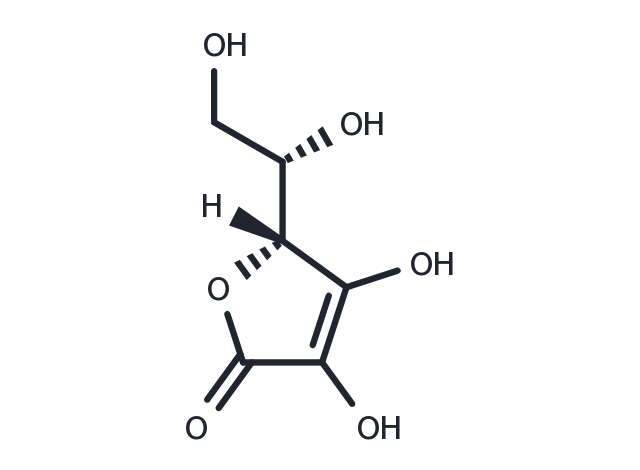Powder: -20°C for 3 years | In solvent: -80°C for 1 year
L-Ascorbic acid (Vitamin C) is a natural product that is a potent reducing agent and antioxidant. L-Ascorbic acid functions in fighting bacterial infections, in detoxifying reactions, and in the formation of collagen. L-Ascorbic acid is used in the treatment of scurvy.

| 説明 | L-Ascorbic acid (Vitamin C) is a natural product that is a potent reducing agent and antioxidant. L-Ascorbic acid functions in fighting bacterial infections, in detoxifying reactions, and in the formation of collagen. L-Ascorbic acid is used in the treatment of scurvy. |
| In vitro |
METHODS: Human osteosarcoma cells MG-63 were treated with L-Ascorbic acid (62.5-1000 µM) for 3-24 h. Cell viability was measured by XTT Assay. RESULTS: Cell viability was consistently >95% when cells were treated with L-Ascorbic acid at concentrations of 0-250 µM. When higher concentrations were used, a dose-dependent decrease in cell viability was observed. [1] METHODS: Melanoma cells WM1366 were treated with L-Ascorbic acid (5-50 µM) for 24 h. The expression levels of target proteins were measured using Western Blot. RESULTS: The lowest concentration of L-Ascorbic acid (5 µM) significantly reduced the normoxic expression of HIF-1α protein in human melanoma cell lines. [2] |
| In vivo |
METHODS: L-Ascorbic acid (1-4.5 g/kg) was administered intraperitoneally to irradiated C57BL/6 mice to detect radioprotective activity. RESULTS: Administration of 3 g/kg L-Ascorbic acid immediately after exposure significantly increased the survival rate of mice after 7-8 Gy WBI. However, administration of less than 3 g/kg L-Ascorbic acid was ineffective, and 4 g/kg and above was harmful to mice. [3] METHODS: To investigate the effects on amnesia, L-Ascorbic acid (60-160 mg/kg) was administered intraperitoneally to diazepam, scopolamine, and aging-induced amnesic Swiss mice once daily for 3-8 days. RESULTS: L-Ascorbic acid improved learning and memory in aging mice, as evidenced by decreased transfer latency and increased descending latency. [4] |
| 別名 | Vitamin C, Ascorbic acid, L(+)-Ascorbic acid, L-Ascorbate |
| 分子量 | 176.12 |
| 分子式 | C6H8O6 |
| CAS No. | 50-81-7 |
Powder: -20°C for 3 years | In solvent: -80°C for 1 year
H2O: 35.7mg/ml(202.8mM)
DMSO: 60 mg/mL (340.68 mM)
Ethanol: < 1 mg/mL (insoluble or slightly soluble)
You can also refer to dose conversion for different animals. 詳細
bottom
Please see Inhibitor Handling Instructions for more frequently ask questions. Topics include: how to prepare stock solutions, how to store products, and cautions on cell-based assays & animal experiments, etc.
L-Ascorbic acid 50-81-7 Apoptosis Immunology/Inflammation Membrane transporter/Ion channel Metabolism NF-Κb Calcium Channel Reactive Oxygen Species Endogenous Metabolite donor antioxidant ROS oxygen Ca channels cancer Electron channel Inhibitor Ca2+ channels inhibit collagen L Ascorbic acid reactive Vitamin C Cav3.2 Ascorbic acid species deposition L(+)-Ascorbic acid L-Ascorbate LAscorbic acid inhibitor
